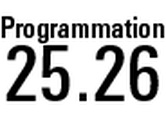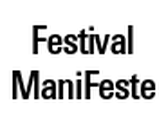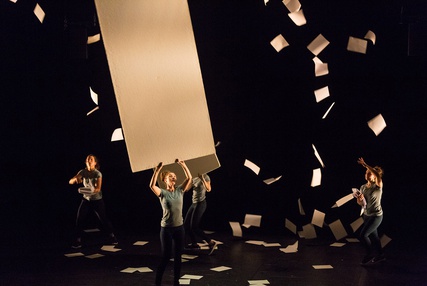In Vivo
Organisés dans le cadre de l’Académie ManiFeste, les ateliers In Vivo invitent de jeunes créateurs à s’aventurer dans une production inédite. Petit aperçu avec l’In Vivo Électro, mené cette année par le circassien Jérôme Thomas et le compositeur Mauro Lanza.
« Je ne sais pas ce qui se passe, mais j’aime ! »
L’exclamation vient de Jérôme Thomas. Debout à l’avant scène, les yeux plissés pour scruter l’obscurité par-delà les projecteurs qui inondent la scène, il s’adresse à Guillaume Tiger, jeune compositeur penché sur la console, en haut des gradins.
« Ça ne patine pas dans la semoule, ça avance ! »
Sur scène, la jongleuse Ria Rehfuß évolue dans un solo tournoyant qui dégage une aura magique : entre ses mains, une large plaque blanche semble voler toute seule, tandis que la salle tout entière est noyée sous une musique aux accents métalliques – comme si la plaque n’était pas en plastique, mais en métal vibrant. Le contraste entre la grâce et la légèreté de la jongleuse et les vagues plus au moins apocalyptiques du discours musical spatialisé est en effet saisissant. Peu après, Jérôme Thomas cherche l’assentiment de Mauro Lanza: « Ça se construit mieux avec Guillaume, non ? »
On ne sait comment exactement, on est venu ici à bout collectivement d’un blocage qui traînait manifestement depuis un moment. À la fin de la pause précédente, Jérôme Thomas s’était entretenu un bref instant avec Guillaume Tiger, en charge de la musique de cette troisième et dernière scène du spectacle. Un «pep talk» qui mêlait encouragement à écouter ses propres intuitions, tout en restant souple vis-à-vis de ce qui se déroule sur scène.
Un travail en constant devenir
Nous sommes à deux jours de la sortie d’atelier de cette session 2016 des In Vivo Électro et la concentration est à son comble. Dans la petite salle du 104, si le regard est immédiatement attiré par les quatre circassiennes/danseuses/jongleuses (Audrey Decaillon, Viola Ferraris, Florence Huet, Ria Rehfuß) qui travaillent sur scène sous l’œil acéré de Jérôme Thomas, elles ne sont pas les seules à s’agiter : trois jeunes compositeurs électro (le Russe Stanislav Makovsky, l’Italien Luca Scapellato et le Français Guillaume Tiger) mettent la dernière main à leurs propositions musicales respectives, conseillés par le compositeur Mauro Lanza et par l’encadrement pédagogique Ircam de Jean Lochard et Augustin Muller. Tout l’enjeu de cet atelier est, pour les unes, d’apprendre auprès d’un maître reconnu du jonglage, pour les autres de se confronter au travail de plateau et, pour tous, d’aller à la rencontre d’une autre discipline artistique, de ses spécificités et de sa temporalité propres, pour mieux interagir avec elle.
Nous sommes à deux jours de la représentation, et pourtant, beaucoup reste à faire. Que ce soit sur le plateau - où les quatre jongleuses sont inlassablement abreuvées d’instructions, d’orientations, de commentaires -, sur la musique et dans le dialogue entre les deux, entre l’image et le son, dialogue qui affecte immanquablement le travail de chacun dans le détail, et refaçonne de fait le rendu global. Certes, les trois tableaux qui composent le spectacle ont été imaginés voilà plus de vingt ans, en 1995, pour la première partie de HIC HOC. Certes, Jérôme Thomas a fixé depuis le début de l’atelier, voilà presque deux semaines, les grandes lignes du spectacle. Mais reprendre un geste après tant de temps, et surtout avec une nouvelle musique, nécessite de nombreux ajustements.
« La première fois que j’ai parlé avec les étudiants, dit Jérôme Thomas, nous sommes très vite entrés dans le concret. Concernant les compositeurs, je ne connaissais pas leur travail, mais je leur ai expliqué le sens de la pièce et les outils dont j’allais me servir pour diriger – leur musique en faisant bien entendu partie. Mon expérience au CNAC ou à l’Académie Fratellini m’a appris que la meilleure pédagogie est de mettre les étudiants dans un contexte propice à la création : concentration, mise en urgence… tout en ménageant de temps à autre des intermèdes pédagogiques afin d’analyser le travail en cours ou les enjeux de créations à l’oeuvre : cela les libère ! »
Le travail de Jérôme Thomas avance ainsi, entre charisme et intuition : si un cap général est donné, la souplesse est le maître mot.
« La forme vient directement du travail de plateau dirigé par Jérôme, dit Mauro Lanza. La forme musicale suit de manière naturelle. C’est neuf pour moi aussi : je n’ai jamais procédé ainsi ! C’est donc très formateur pour moi également. Mais, quand on m’a proposé de diriger cet atelier, j’ai tout de suite été fasciné par l’univers de Jérôme et la qualité quasi “slapstick” de ses jongleries. »
De fait, les jongleries continuent à s’affiner, de même que l’interaction entre action scénique et musique. L’arrivée la veille de Bernard Revel, en charge des lumières, vient à la fois enrichir et complexifier les interactions déjà très délicates entre les deux discours. Dans la première scène, par exemple, durant laquelle les quatre jongleuses manipulent de longues cannes terminées par des balles blanches, Luca Scapellato a recours un outil de captation de mouvement pour nourrir le discours électronique. Le dispositif consiste en une caméra vidéo qui permet de suivre en temps réel l’évolution des balles qui reflètent fortement la lumière. Cachées dans l’obscurité, les jongleuses donnent le sentiment que les balles qu’elles manipulent virevoltent toutes seules dans l’espace, à la manière d’un long serpent ou de lucioles. L’irruption de la lumière est donc un paramètre nouveau susceptible de bouleverser un discours pourtant déjà bien calibré.
Jérôme Thomas est l’un des pionniers de ces technologies de captation de geste appliquées au jonglage et à la musique. L’histoire remonte à ses rencontres successives avec les compositeurs Henry Fourès et Luc Ferrari, dans les années 1990. C’est grâce au second que Jérôme Thomas découvre le concept de « partition de jonglage ». Quelques années plus tard, cette partition de jonglage deviendra partition sonore lorsqu’il développera, en relation avec l’Ircam et plus particulièrement avec Augustin Muller, un dispositif de capteurs destiné à maîtriser des sons électroniques.
« La virtuosité est déplacée, dit-il. Ce n’est plus de l’illusion de l’image, mais sa sensation sonore qui importe, ce qui lui confère une certaine densité. Comme si l’image prenait du poids, devenait mur. »
Contrepoint glissant
Dans la deuxième scène, un autre enjeu se fait jour : celui de la synchronisation entre jonglerie et musique. Pourtant, rappelle Jérôme Thomas, l’une des grandes avancées de ces dernières années, c’est que l’on se préoccupe moins du « calage exact du plateau sur la bande-son. Notamment grâce aux nouveaux outils, mais pas uniquement. Résultat, les acteurs subissent une pression moindre pour respecter la mesure musicale, ce que donne une grande force visuelle.» Dans le cas présent, toutefois, il s’agit non seulement d’accorder les ressentis temporels des deux discours en contrepoint, mais de synchroniser les fins des deux processus. Dans cette scène, des élastiques tombent des cintres, que les jongleuses font tournoyer. À la fin, elles les font tourner comme des toupies puis les relâchent – et c’est à l’instant de leur déroulement complet que Stanislav Makovsky veut déclencher un joli effet dans sa partition noise, percutante et rythmée.
La tension est palpable entre Jérôme Thomas et le reste de l’équipe durant toute cette séquence de travail : l’agacementest manifeste, de même que l’impatience et quelques malentendus. « Ce temps est laborieux pour moi, se crispe Jérôme Thomas, mes acteurs ne peuvent pas attendre, ça se voit trop sur scène. »
Sur la suggestion de Mauro Lanza et Jean Lochard, on fait une nouvelle tentative – mais, cette fois, c’est la toupie qui repart dans l’autre sens (ce qui n’est pas censé se passer), provoquant un nouveau raté. Finalement, tout se calera, non sans difficulté et appréhension quant à la représentation si proche.
Élève du Conservatoire de Paris en composition, électronique et improvisation, Stanislav Makovsky s’est engagé pour cet atelier In Vivo à la confrontation ultime avec le plateau, puisqu’il descendra lui-même sur scène avec un instrument électronique, pour improviser entre les jongleuses. À mi-chemin entre le bâton et la guitare, produisant un son très bruité à la manière d’une guitare électrique sursaturée, cet instrument suscite un jeu instrumental très théâtral, à la manière d’une manipulation d’objet. S’avançant sur scène tel un spectre ou une rock star, il s’inscrit parfaitement dans le magnifique jeu d’élastiques qui quadrille l’espace.
Par Jérémie Szpirglas



